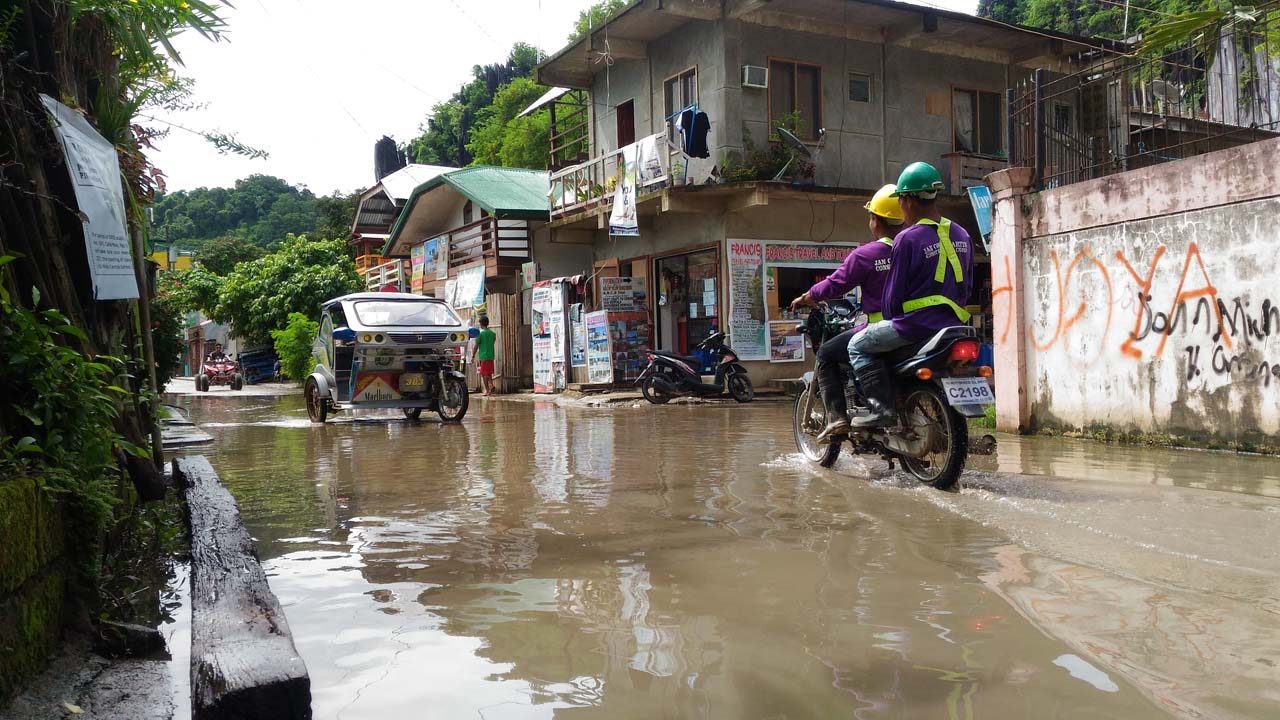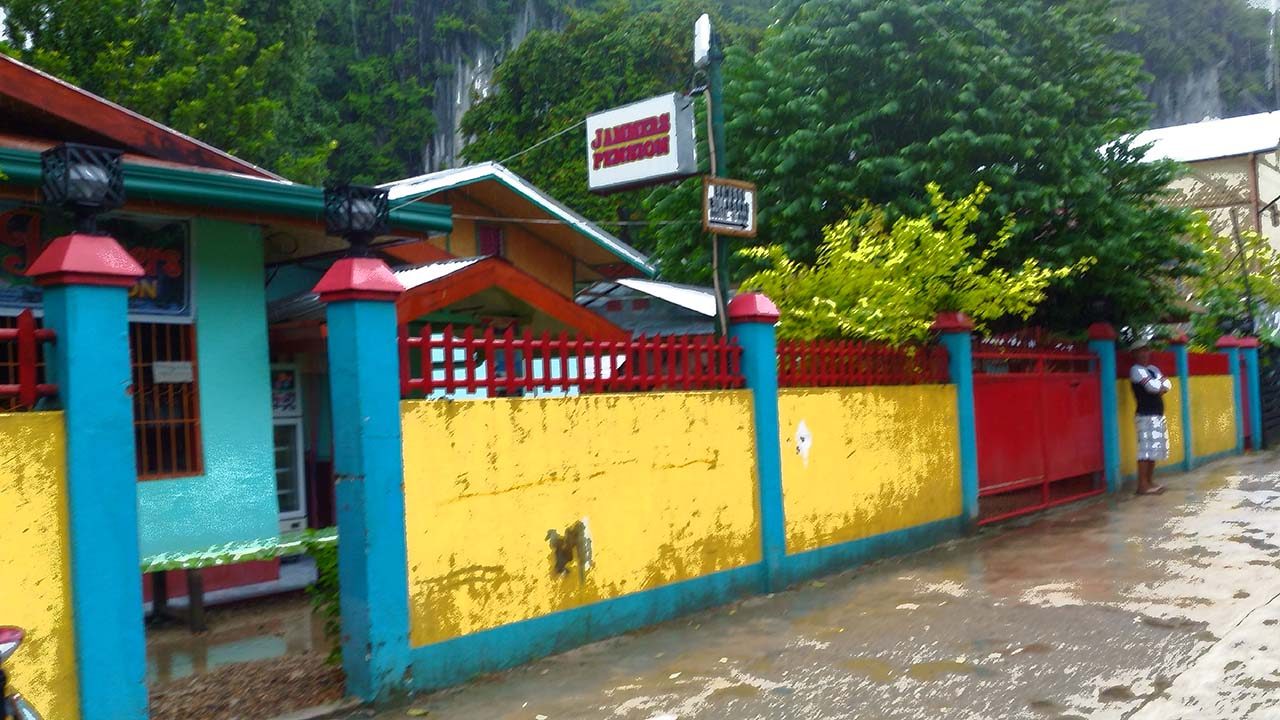SUMMARY
This is AI generated summarization, which may have errors. For context, always refer to the full article.

PUERTO PRINCESA, Philippines – Downtown El Nido can get really flooded when it rains, to the discomfort of the many tourists visiting the town for its famous sea lagoons, islands, and beaches.
During the rainy season, the lower areas of the town get flooded easily, and it is common to see locals and tourists wading through foot-deep flood.
Despite being a top tourist destination, this first-class town lacks a storm drainage system that can control street flooding, a problem that the municipal government wants to address.
“As you can see, the roads of El Nido are sea-like,” Mayor Nieves Rosento told Rappler. “Because of the ongoing concreting of almost all establishments, rainwater runs off on the paved road surface.”
Rosento admitted that the former town administration, which she served as vice mayor and municipal board member, did not see this situation coming. “Before, rainwater on the street just subsided,” she added.
To fix the drainage problem, the municipal government has to hurdle an obstacle to its immediate construction – convincing owners of residential homes, tourist inns, and other business establishments to observe the setback required by law.
The planned setback is a one-meter distance between the building and the main road, based on a municipal ordinance passed in 2005 yet hardly observed in El Nido. Strolling around the downtown, one will notice how buildings occupied even the no-take areas, leaving no space for storm drainage and sidewalks.
“Those who will be affected don’t even have at least half meter. And the canals, as we can see, they’ve made it part of their business establishments,” Rosento said.
Beside the construction of storm drainage and sidewalks, the one-meter setback has been extended to up to 1.7 meters to give way to the separate pipelines for the water supply and sewage and wastewater treatment system projects in the town.
Giving back vs compensation
To finally kick start the project, Municipal Administrator RJ de la Calzada said they are negotiating with property owners who are reluctant to comply.
“They earned a lot from El Nido’s Bacuit Bay. It’s a way of giving back. Remember, the tourists come here not because of their establishments but for nature,” De la Calzada told Rappler.
Among the estimated 10% affected establishment owners is retired navy officer Jun Carollo, 61, who has a pension house along one of the busy streets in El Nido. His titled land property is enclosed by a concrete wall that touches the paved road.

In his case, observing the setback means self-demolishing his fence, costing around P170,000, without compensation from the municipal government. Others, meanwhile, have to chop a portion of their building which protrudes toward the main road.
“I’m not against those projects. But if we’re to agree with the setback, will we get paid for the portions to be cut off from our land property? Will they make an adjustment on our land tax that we’ve been paying for so many years?” Carollo said.
To this Rosento said: “Definitely, the local government has no capacity to pay them. That’s why we’re negotiating with our affected constituents, so as to convince them to give way because these projects are for the common good.”
The mayor explained that “just compensation” may be given only if the government was going to use the property for recreational purposes.
She reminded establishment owners that they signed a voluntary waiver the last time they renewed their business permit. In signing the waiver, she explained, they agreed to let the municipal government take over the area for a setback to accommodate any government projects.
As for the land tax adjustment, Rosento said there would be deductions upon reviewing their documents. “If it’s part of the title, we will have it re-surveyed, so we can take the setback space out of their existing property,” she said.
Asked what actions the local government will take on those who refuse to comply, Rosento said such cases will be referred to their legal team who will request permission from the court to execute the phase out.
Meanwhile, critics say the setback issue could have been addressed at the very start had the past administrations ruled with an iron fist.
Former municipal board member Rico Fernandez said the problem was created by the municipal government itself when it did not properly monitor the construction of business establishments before issuing business licenses or mayor’s permits.
Rosento refused to comment on the matter out of “respect to the past administrations,” and instead encourages the people to “focus on the urgency of the present situation.”
Water quality
Water quality is also a cause of concern in El Nido as there have been cases of loose bowel movement, sepsis, and cholera after drinking untreated water, said Aynon Gonzales, director of Palawan State University’s Center for Strategic Policy and Good Governance.
Gonzales raised the issue at a sustainable tourism forum organized last week by El Nido Resorts, in cooperation with student fellows from Ateneo de Manila University and Georgetown University.
Through the Capturing Coral Reef Ecosystem Services (CCRES) project, Gonzales’ team studied El Nido’s water pollution problem and discovered that the coastal population’s disposal of solid and liquid waste was the top cause of pollution.
“Population growth, migration, tourism and resort development are tourism-related pressures that drive those activities,” she said, addressing 138 participants composed of barangay and municipal government officials, people’s organization leaders, establishment owners, among other concerned citizens.
“If we didn’t address these nutrients and it will go to our water bodies, that would cause water pollution,” eventually degrading the town’s groundwater and coastal water, she warned.
El Nido gained unwanted attention in 2014 when it was widely reported that the water quality along the town shoreline had exceeded the allowable limits of pollutants set under the Philippine Clean Water Act of 2004.
With the implementation of septage management ordinance, the municipal government assured that pollution levels have since gone down, and the downward trend is likely expected with the construction of the centralized sewage treatment plant in two years time. – with reports from Melba Pagayona Daganta/Rappler.com
Add a comment
How does this make you feel?
There are no comments yet. Add your comment to start the conversation.